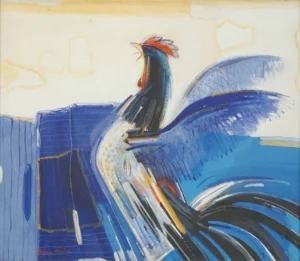Art & Collector

Art Collection & Beyond
Folk art, music, and other forms of art practices have a fairly long history and tradition in Bangladesh. However, there is still a lot of inconsistency about how we properly institutionalise, engage, and treat our own important art and artists, even though a lot of young people go to major exhibitions, mass concerts, and festivals every once in a while. Although there has been a noticeable improvement in the scene that developed in the past few years, especially in the post-pandemic era, the majority of the prominence that we see in social media is still inside a Dhaka-based bubble. Historically, there always had been a lack of responsible actions from the state or government regarding the endorsement of the overall art scene and practice. Not enough quality art education for everyone in schools and even not enough quality art education at universities, the fact that most people are interested in and involved in mainstream art, and facts like some people don’t take part in art responsibly and certain forms of art can be hard to get to are all things that contribute to the problem. In this reality, passionate art collectors and patrons are very rare breeds in Bangladesh. For a long time, Durjoy Rahman had quietly been a prominent figure in the Bangladeshi art scene. He has been personally collecting art for roughly three decades now; it was only in 2018 that he decided to go for a more institutionalised format for further contribution to the local art scene and founded the Durjoy Bangladesh Foundation. Despite the pandemic years and Durjoy’s preference of operating the foundation with very selective personnel, the foundation is promisingly making a name for itself within the niche of the local scene, the Global South, and the wider international art arena. “Many people misinterpret that the foundation is named after me, but the word Durjoy roughly translates as indomitable or invincible in Bengali. I had that in mind while naming the foundtion. Invincible/indomitable Bangladesh is the spirit of DBF,” said Durjoy to Ceramic Bangladesh Magazine at his office for a short but engrossing conversation about art, business, and life over cups of tea and biscuits. Soft-spoken, a bit formal with conversations, and always a well-dressed gentleman with a fatherlike old-school discipline, Durjoy carries a distinct eccentric aura—perhaps like that of many artists. Durjoy’s persona transcends the boxes of notions that are typically associated with the term “rich businessman turned art collector.” Speaking of art collection, he is also known for his amazing collection of various vintage cars. With his businessman father, who was a prominent name in the Jamdani trading scene back in the day, and a mother who was a doctor in the army and a freedom fighter who contributed to the liberation war of 1971, his knack towards business and having a soft corner for Bangladesh is perhaps unsurprising. You grew up in Dhaka cantonment. Do you remember your earliest influence of art— that intrigued you deeply? Absolutely! When we were young, there was a popular weekly literary magazine called ‘Bichitra’. I used to admire its design and the published cartoons. It was the timeline when the famous “Tokai” series by our very own modernist Rafiqun Nabi started getting published in the weekly, and I became a big fan of it. Later in life, when I started collecting, Nabi’s work was my first ever purchase, and now I have over 70 works produced by him. This gives me intense joy; it is as if I am satisfying my inner child. How was the local art and exhibition scene back then, given the type of crowd, their engagement, and the collectors? Furthermore, if we compare the eras of Muzharul Islam, Novera, S M Sultan, Murtaja Baseer, and the other renowned figures practicing the contemporary art scene of Bangladesh, it seems that what they did, considering time context, we still haven’t reached that level of quality despite having a lot more privileges now. There was always a very few collectors and patrons. Given the popularity of cinemas back then, there was always a regular crowd at the theatre shows, but it wasn’t often that we got to see a large number of crowds at exhibitions. The people of the crowd were not as young as those of today. If we talk about the number of people engaging, overall it is a lot more now. These are the big differences if we compare. Speaking about the improvement, I think the quality of contemporary art in Bangladesh is still pretty strong and not something to be undermined. We tend to think that artworks produced during those times are superior compared to contemporary Bangladeshi art, but I don’t entirely agree with that. I think some artworks produced these days are also timeless and very important. In the early 90’s, you entered the design and textile industry and had been successful with your entrepreneurial venture, Winners Creations Ltd. The company has a valuation of over 40 million USD. As a veteran businessman, what are your thoughts regarding the ceramic industry of Bangladesh? If we look at the financial reports, I think they are doing fabulous. It’s a growing industry, and ceramic-based products will always have their demands globally because of how we use them in our day-to-day lives. In my opinion, I think there is always room for improvement in the design. We usually don’t incorporate our local motifs; we don’t utilise our local artisans and talented young designers properly. For example, using elements from rickshaw art. Notably, when I visited Spain and Japan, I saw how beautifully they brought their influence of art into their ceramic products.
Read More
